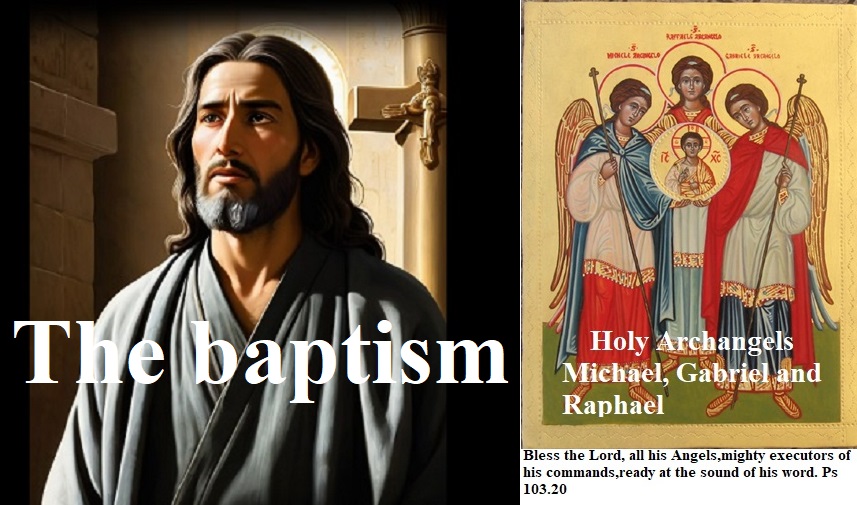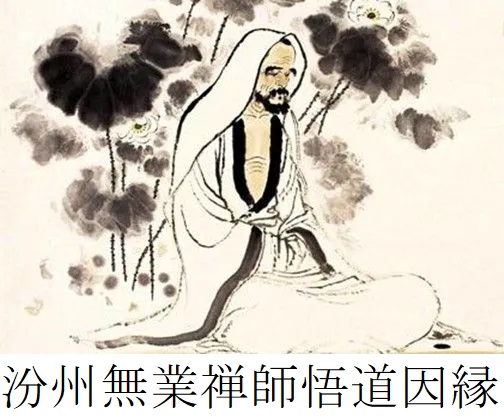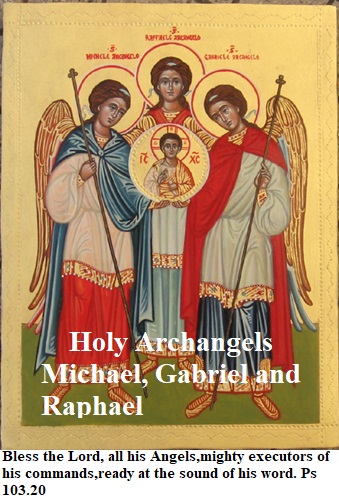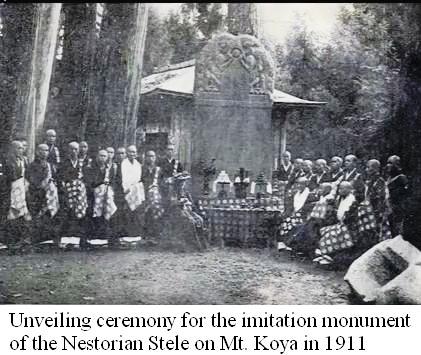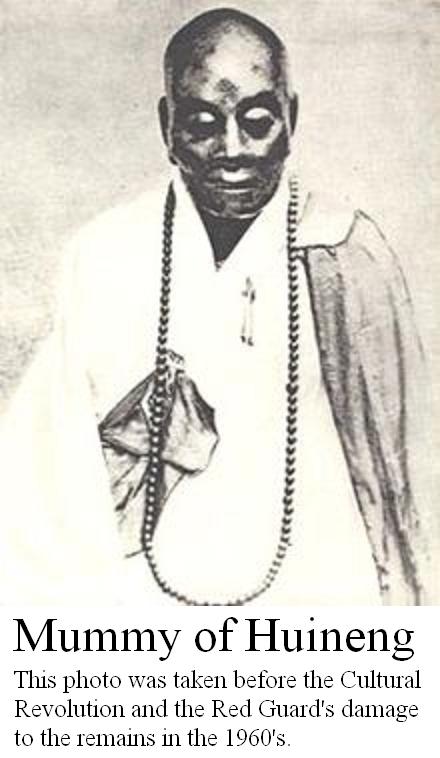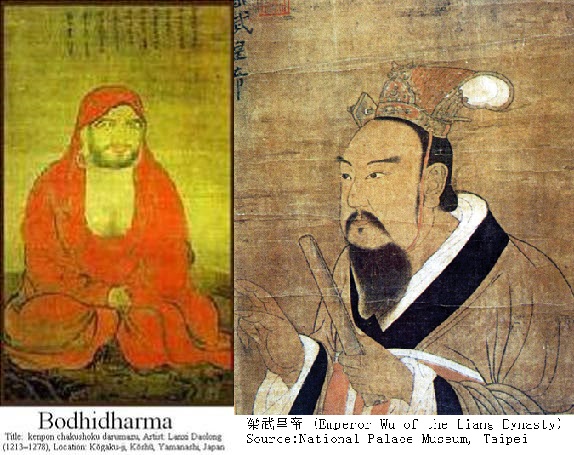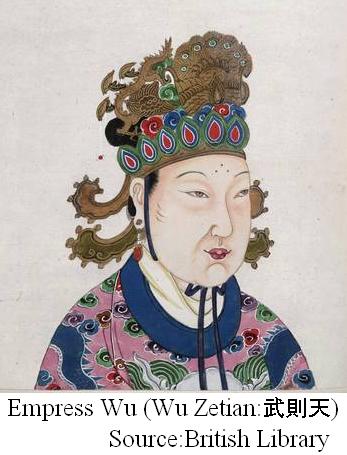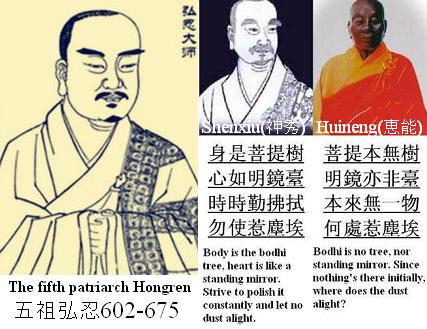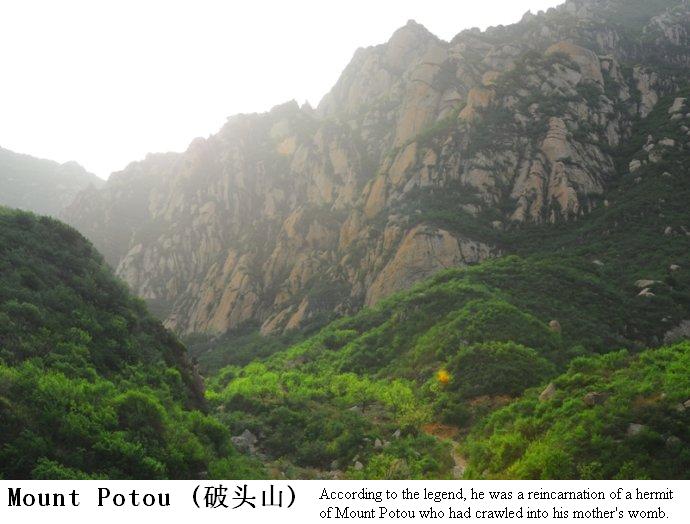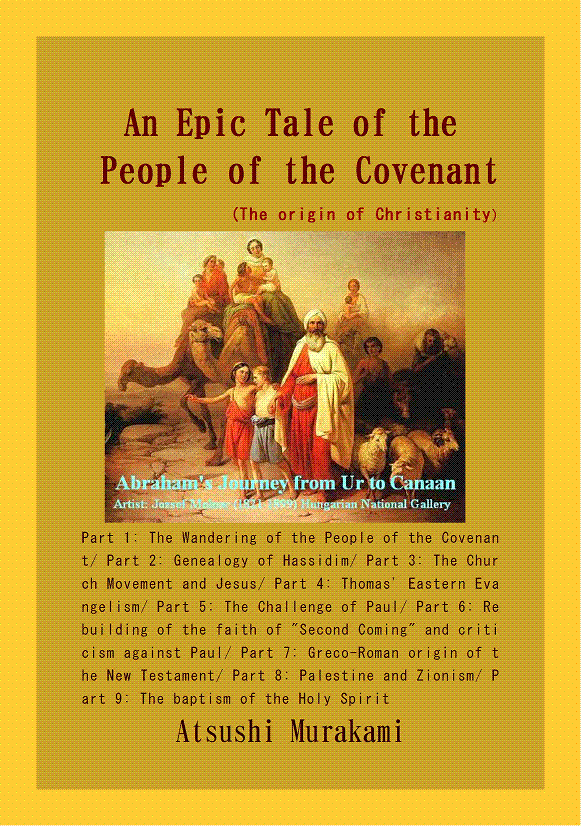Jesus said, "The Spirit gives life; the flesh counts for nothing. The words I have spoken to you are spirit and they are life." (John 6:63) He intended to transfer to us God itself or The Holy Spirit, which could not be expressed in words and letters, in other words, he wanted to baptize us with The Holy Spirit.
According to the Gospel of Thomas, recognition of the original self as 'the children of the light' or 'the children of Father' is the realization of the Kingdom of God and it is the essence of 'the baptism with the Holy Spirit.'
Mo wangxiang (Stop your deluded thought!)
There was a Zen monk, who held up "Mo wangxiang(莫妄想: stop your deluded thought!)" as the sole banner of his school and became famous during Tang Dynasty of China. Whenever he received questions from students would reply by saying, "Do not have deluded thoughts." And in his later years he received an imperial order from the 15th Emperor Muzong (穆宗reigned 820-824)and lived in Fen-zhou of Shanxi Province and was known as the Zen master Fenzhou Wuye(汾州無業禅師).
At the age of 9, this man received the Mahayana Sutra(大乗経) from Zen Master Zhi-ben(志本) of Kai-yuan-si (開元寺) Temple, memorized the Five Element Theory thoroughly, shaved his head at the age of 12, and at the age of 20, he received the precepts under Buddhist discipliner You(幽律師) of Xiang-zhou(襄州) and studied Sifenlvshu(四分律疏) and then taught the Nirvana Sutra(涅槃経) to monks. Thus, he appears to have been an excellent person who was well versed in Buddhist studies in his youth.
There was a Zen master called Mazu Daoyi (馬祖道一709-788) who had established Hongzhou school(洪州宗), one of major sects of the Zen Buddhism, based at the Kaiyan-si (開元寺)temple in Hongzhou(洪州) of Jiangxi province(江西省) in China at that time. He emphasized everyday life itself than studying scriptures or meditation and taught students using extraordinary actions and tactics suited to each occasion. He is also known with his many wise remarks, such as, "The ordinary mind is the way(平常心是道)," "Each mind is a living Buddha(即心即仏)," "Actions are Buddha-nature(作用即性)," and so on. Therefore, young Wuye also decided to visit Zen Master Mazu Daoyi.
Seeing this young man's dignified appearance and hearing his voice sounding like a big temple bell, Matsu said, "The Buddha Hall is magnificent, but there is no Buddha inside."
The young man knelt down and asked honestly, "Although I have studied the literature of the Three Vehicle Sutras(三乘経), that is, vehicle of the hearers(声聞), vehicle of the pratyekabuddhas(縁覚) and vehicle of the bodhisattvas(菩薩), and have heard the Zen teaching of 'Immediate Mind is the Buddha(即心是佛),' I still do not understand it."
Then Mazu replied, "That's what you said, 'I still don't understand.' There's nothing else."
The young man then asked again, "What is the Mind Seal that Bodhidharma came to the West and handed down to us?"
Mazu said, "Hey, Guy of Great virtue, you are little annoying. Just leave it at that for today and come again.''
When the young man was about to leave, Mazu abruptly called out to him in a loud voice, "Oi, great virtue!" When the young man turned around, he yelled, "What are you doing?" When the young man suddenly realized this and prayed, Mazu chided him, saying, "What are you doing at this hour, you idiot?"
[Zen master YunJu(雲居), holding his staff(錫杖), says: What is it about Fenzhou(汾州) that is so noisy? ] (Jingde Chuandeng-lu Volume 28)
YunJu-DaoYing(雲居道膺:830-902), who is said to have been the head of disciples of DongShan-LiangJie (洞山良价:807-869), the founder of the CaoDong School (曹洞宗) of Zen Buddhism, gave advice to each scholar who participated in Zazen (坐禅) with this koan(公案), while shaking his cane(錫杖) and said, "Now, tell me what is bothersome about Fenzhou."
Actions are Buddha-nature
From the beginning, above the causes of the enlightenment of Zen master Wuye has been used as a koan for "Zuoyong ji Xing(作用即性:Actions are Buddha-nature)." "Zuoyong" means "action," that is, 'human activity' or 'the very existence of human beings' is Buddha-nature.
The characteristic of Mazu Zen was that it did not make people understand his Zen style, that is, 'extraordinary actions and tactics suited to each occasion,' as ideals, but rather made them realize them as living facts in their own lives through questions and answers. He called this principle "Zuoyong ji Xing(作用即性:Actions are Buddha-nature)."
According to Professor Takashi Ogawa(小川隆) of Komazawa University(駒澤大學), question-and-answer sessions in the Tang Dynasty were a one-off incident that occurred naturally during the life of an ascetic. In the Song Dynasty, the records of the questions and answers of our predecessors were selected and compiled as classics shared by the Zen school, and these were given to monks in training as subjects for their training. The records of the questions and answers of our predecessors that came to be used in this way are called "koans(公案)."
During the Song Dynasty, the standardization of koans as teaching materials and teaching methods progressed. The methods of studying "Koan" can be roughly divided into two types: "Wenzi-can(文字禅)" and "Kanhua-chan(看話禅)". "Wenzi-can" attempts to clarify Zen by making full use of the knowledge of classical poetry and writing short comments on the koan, composing the purpose of the koan in poems, and adding commentary in prose. On the other hand, "Kanhua-chan(看話禅)" refers to "Huatou(話頭)", that is, ``watching'' the koan, but specifically, it involves focusing one's whole body and soul on one koan, pushing one's consciousness to the limit, and reaching its peak. This means that one can experience an absolute great enlightenment by causing an explosive attack on one's mind. (Excerpt from Professor Takashi Ogawa's article "From Tang Dynasty Zen to Song Dynasty Zen: Mazu and Dahui" published in Komazawa University Zen Research Institute Annual Report No. 32. December 2020)
Origin of Koan
So, why did the records of the questions and answers of Zen's predecessors come to be called koans (court cases)? This seems to be deeply related to the doctrine of ``the last day = final judgment'' preached by Nestorians.
The Greek word Parakletos ('ο Παρακλητος) in the Chapter 15 verse 26 of the Gospel of John ("When the Counselor comes, whom I will send to you from the Father, the Spirit of truth who goes out from the Father, he will testify about me.") is translated to 'Comforter,' 'Counselor' and 'Advocate' in the English Bibles, that is. the King James Version (KJV), the New International Version (NIV) and the New Living Translation (NLT) respectively. The hard work for the each translator can be seen there.
The original text of Q Source that the author of The Gospel of John referred to here should be the following description of verse 88 of The Gospel of Thomas.
Jesus said, "The messengers and the prophets will come to you and give you what belongs to you. You, in turn, give them what you have, and say to yourselves, 'When will they come and take what belongs to them?'" (Thomas 88)
That is to say, what the Spirit of truth will give to us has belonged to us from the beginning. Therefore when we are baptized also depends on ourselves, or when we are prepared. In other words, when we have discovered that we have been one with God from the beginning, we will be baptized with the Holy Spirit. (Hensho: 2020-09-01)
Daqin Jingjiao Popular Chinese Monument (Nestorian Stele)
Zen Buddhism was brought to China by Bodhidharma from India during the Northern and Southern Dynasties period (439-589), and it merged with Nestorian Christianity, which penetrated into China around the same time, and seems to have exploded into popularity during the Tang Dynasty (618-907).
In 635 AD, Alopen (阿羅本: Abraham) led 21 Jingjiao followers, headed to China and met Emperor Taizong (太宗) of the Tang (唐) Dynasty and presented a Chinese translation of the Bible. Then Jingjiao was officially authorized to propagate in China. These facts are recorded on 'Daqin Jingjiao Popular Chinese Monument (大秦景教流行中国碑: Nestorian Stele),' which was discovered in Xi'an (西安) in the 17th century by the Society of Jesus (Jesuits). However, this is an official record, and it appears that the Jinngjiao followers had been preaching in China before then.
In 804, Kukai, the founder of Japanese Esoteric Shingon school (日本真言密教) of Buddhism, took part in a government-sponsored expedition to China. The court of Tang Dynasty (唐朝) granted Kukai a place in Xi Ming Temple (西明寺) in 805. After that, Kukai studied Shingon Esoteric Buddhism from Qinglong Monastery (青竜寺)'s seventh ancestor Huiguo (恵果746–805), and was recognized as the eighth ancestor of the Shingon sect. Kukai learned Sanskrit from Panruo Sanzang (般若三蔵), a friend of Jingjing (景浄) who was the author of the inscription of Nestoriam Stele (景教碑). Therefore, Kukai seems to have had friendships with Jingjing and other Jingjiao followers such as Yisi (伊斯Isaac) who were active in Chang'an (長安) at that time. For this reason, there is the imitation monument of Nestoriam Stele given by Mrs Elizabeth Anna Gordon (1851–1925), a Jingjiao researcher, to Mt. Koya (高野山), the headquarters of Japanese Esoteric Shingon school, in Wakayama Prefecture (和歌山県).
The contents of the third volume of 'Shizun bushi lun (世尊布施論The Lord of the Universe's Discourse on Alms-Giving)', owned by Kyoto Nishi Honganji Temple (京都西本願寺), almost corresponds to 'the Sermon on the Mount' in a Chinese translation of the Gospel of Matthew, which was written by Jingjiao followers, and a part of Adam's birth story is also seen there.
Therefore, "Baptism with the Holy Spirit" of Thomas, who is said to have been the twin brother of Jesus, seems to have been fused with Mahayana Buddhism and Taoism after he had brought it to India and China, where these tide of thought were emerging at that time, and to have contributed to the flourishing of Pure Land Buddhism and Zen culture as well as birth of Islam.
By the way, at the beginning of Jingde Chuandeng-lu, Part 28(景徳伝灯録巻), it has an introduction reminiscent of the New Testament's "Annunciation." It says, "One night, a girl from the Li family(李氏) in Shangluo(上洛), Shangzhou City(商州市), Shaanxi Province(陝西省), heard a voice in the air asking "if I could stay there", she found out that she was pregnant. After ten days and ten months, the birthing house was filled with divine light, and the girl gave birth to a boy. As soon as this boy, whose common name was Du-shi(杜氏), was able to crawl, he sat on lotus position and meditated.
The succession to the sixth patriarch
A tonsure ceremony of a young man was held at Faxingsi temple (法性寺) in Guangzhou, Guangdong province of China on the 15th of January in 676 AD, the third year of ShangYuan period of Emperor GaoZong (高宗) of the Tang dynasty. And a grand ordination ceremony was held on the 8th of February inviting famous Buddhist discipliners from nationwide and abroad such as ZhiGuang (智光) of Xian (西安), HuiJing (慧静) of Suzhou (苏州), TongYing (通应) of Jingzhou (荆州), QiDuoLuo (耆多罗) of Central India and Master Tripitaka MiDuo (蜜多) of Turkestan as a master of ordination, a master of karma (羯磨), a professor, a teacher of precepts and a witness of ordination respectively. In this way, the succession to the Sixth Patriarch of Zen Buddhism since Bodhidharma had transmitted the Mind Seal to China by the lad named Huineng (惠能) was realized.
Fulfillment of prophecy by two Master Tripitakas
Dating back from this 256 years ago, in 420 AD, during the era of Emperor Wu of Song in the Wei, Jin, and Southern and Northern Dynasties period, Indian Master Tripitaka Gunabhadra (求那跋陀罗394-468) prophesied, "A Bodhisattva in flesh will receive the full precepts at this altar in the future," when he built a Buddhist ordination platform here and 176 years ago, in 502 AD, that is, the first year of TianJian, the era name of Emperor Wu of Liang Dynasty, another Indian Master Tripitaka ZhiYue (智药) planted two Bodhi trees here and prophesied, "A Bodhisattva in flesh will be coming here and will preach under the trees and save abundant sentient beings after 170 years later. He will be the savior of the world conveying the Mind Seal of Buddha." Now their prophecies were fulfilled. And even today, after over a thousand years, the seven-story tower built in the precincts of the temple is said to still contain HuiNeng's hair.
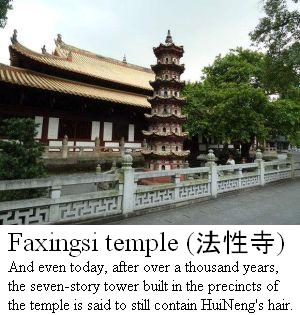
Although HuiNeng was only a young (39 years old) street hawker of firewood in the town of Guangzhou until then, he shoved many high priests aside and suddenly succeeded to the Sixth Patriarch of Zen Buddhism in China. Therefore, the tonsure and ordination ceremonies of HuiNeng are said to have been a landmark incident in the history of Chinese Buddhism, just like, Jesus, the son of a Nazarene carpenter, suddenly appeared alone on the banks of the Jordan River and was baptized by John the Baptist (Mark 1:9/ Mat 3:13) and made a debut to the religious society of Jerusalem with testimony of John in Bethany. Jesus, too, is said to have been in his mid thirties at that time (Luke 3:23).
By the way, the Passion of Jesus, the son of a Nazarene carpenter, was prepared carefully by all parties concerned, including the high priest, the royal family and the Roman governor, in order to establish the Jerusalem Church as an umbrella organization supervising the church movement by overseas gentile believers and different Jewish factions in the country under the leadership of James the Less, the brother of Jesus, who had been certified as the legitimate lineage of the High Priest representing both the Davidic royal family as well as a priestly Aaronic Lineage. It would have been very difficult to complete all procedures during only net one day before the Passover, without prior coordination of all parties concerned, such as investigation, trial, execution and burial of Jesus in charged by the high priest, the king and the Roman governor before sunset. Moreover the Primitive Church was established at the meeting place of the Essenes adjacent to the residence of the High Priest Caiaphas, barely one and half month after the Crucifixion and about three thousand new believers including Gentiles were added to the church that day. (Acts 2:1-41) Thus James succeeded to the first bishop of Jerusalem Church. However, neither James nor Paul, but Peter, a fisherman from the Sea of Galilee, was canonized as the first Pope of Roman Church. Incidentally Galilee was populated and governed predominantly by the Itureans, who were called Ismaelites (Arab) and were mass converted to Judaism during the Hasmonic era, according to Mr. Shlomo Sand, Professor of history at Tel Aviv University. It might have been for this reason that the disciples of Jesus did not know many of the rules and precepts of Judaism. They were blamed for their behavior not only by the Pharisees but also by the disciples of John the Baptist.
Bodhidharma's visiting China
According to the Jingde Records of the Transmission of the Lamp (景德传灯录, published 1004 CE), Bodhidharma, who left South India to travel to China during the era of King YiJian (异见王the nephew of Bodhidharma) and arrived in Guangzhou, China in 527 AD, met Emperor Wu of Liang Dynasty on the 1st of October of the year. Bodhidharma was 150 years old and Emperor Wu was 64 years at that time.
The Emperor declared, "Since my accession to the throne, temples have been built, scriptures copied, and monks saved without number. What kind of merit has been accumulated?" Bodhidharma replied, "No merit." Again the Emperor asked, "What is the first principle of the holiness?" Bodhidharma replied, "Clear and void, no holiness." The emperor did not match him. Finally, Bodhidharma crossed the Yangzi River and came to the kingdom of Wei.
He lived in the Shaolin temple on Mount Song in Henan Province, where he faced a wall for nine years, transmitted the Mind Seal to Huike (慧可), DaoYu (道育), ZongChi (总持nun), DaoFu (道副) and other disciples and passed away at his about 160 years old, according to tradition. He is said to have been caught up in a coup d'etat of Northern Wei (the mass executions at Heyin 河阴的大屠杀) and also said to have been poisoned.
General Erzhu Rong (尔朱荣) refused to recognize the young emperor, Yuan Zhao (元釗), who Empress Dowager Hu (胡太后) had placed on the throne after she poisoned her son Emperor Xiaoming (孝明帝). Erzhu overthrew her and put Emperor Xiaozhuang (孝庄帝) on the throne. Erzhu ordered Empress Dowager Hu and her imperial officials to his camp at Heyin (河阴) near Luoyang (洛阳) and slaughtered them, killing more than 2,000 of them
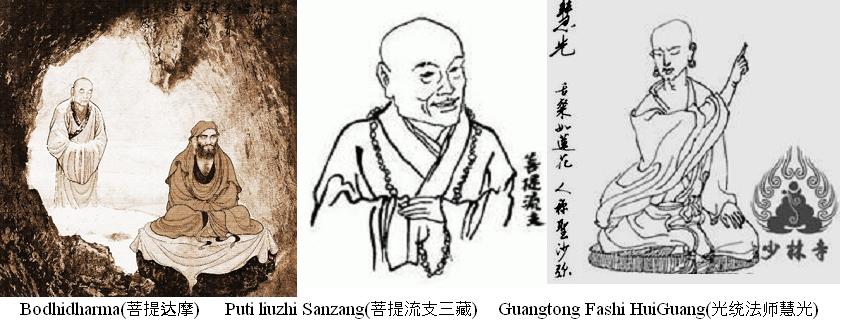
According to some Buddhist Scriptures, such as "Lidai fabao ji (历代法宝记: Record of the Dharma-Jewel through the Ages)," Bodhidharma was poisoned six times. One day, Bodhidharma said to HuiKe, "I came to China because I saw people here with the Great Vehicle Root Nature. Now I have transmitted the Dharma and am ready to complete the stillness." Then he met his death calmly when he was attempted the sixth poisoning. However, there are somewhat strange points in this tradition. Both of Puti liuzhi Sanzang (菩提流支三藏) and Guangtong Fashi HuiGuang (光统法师慧光), who are said to have envied Bodhidharma and to have tried to poison him six times, were prominent high priests of those days. Puti liuzhi Sanzang was a scholar of Yoga practice of Mahayana Buddhism from North India and a translator of Buddhist scriptures. HuiGuang, who had studied under the Venerable BaTuo of the Shaolin Temple, absorbed in the secrets of Hinayana Buddhism Meditation, the School of Vinaya, Huayan Sect and so on and had a lot of disciples. In contrast, Bodhidharma faced a wall for nine years in a cave behind Shaolin Temple and only got a few disciples. The two famous high priests seem to have had little reason to be jealous of the barbarian obscurity, Bodhidharma. More over, there are some points in the story which is convincing to us to believe that Bodhidharma knowingly ate the meal mixed with poison each time. The two high priests gradually increased the amount of poison contained in the vegetarian meals to offer him. Bodhidharma is said to have spat out the poisonous food on a rock every time and the rock changed its color caused by the miasma. Thus the three might have collaborated and have tried to develop new treatment method using India's traditional systems of medicine like Ayurveda, Unani, Homoeo and Siddha and Chinese Medicine.
Furthermore, it is almost impossible to believe that a man, who was 150 years old, not only crossed seas all the way from South India and arrived in Guangzhou of Southern China but also traveled further more than 1,200 km to Mount Song in the outskirts of Luoyang located in the central plains of China. Because recently, Buddhist scriptures which have a lot in common with "The Two Entrances and Four Practices《二入四行论》," a text traditionally attributed to Bodhidharma, were discovered from the ruins of Dunhuang (敦煌), the theory argued that Bodhidharma came to China through land route rather than sea route is considered to be more likely.
"The Record of the Buddhist Monasteries of Luoyang《洛阳伽蓝记》", one of the principal Chinese sources, describes Bodhidharma as a Persian from the western region (西域). The western region refers to Central Asia but may also include the Indian subcontinent. However, Bodhidharma is often referred as "The Blue-Eyed Barbarian (碧眼胡僧)" in Zen texts. If he came from India should have been called "The Blue-Eyed Indian (碧眼天竺僧)."
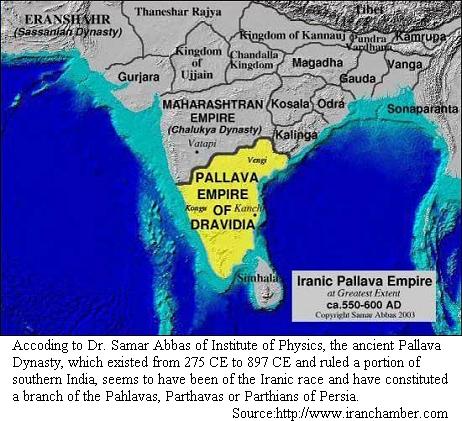
On the other hand, an Indian tradition regards Bodhidharma to be the third son of a Tamil Pallava king from Kanchipuram and to particular characterize as a dark-skinned Dravidian. Tanlin (昙林506–574), too, describes Bodhidharma as the third son of a great Indian king in his preface to "the Long Scroll of the Treatise on the Two Entrances and Four Practices." According to Dr. Samar Abbas of Dept. of Physics, Utkal University and Institute of Physics Bhubaneswar, India, the ancient Pallava Dynasty, which existed from 275 CE to 897 CE and ruled a portion of southern India, seems to have been of the Iranic race and have constituted a branch of the Pahlavas, Parthavas or Parthians of Persia.
Wu ZeTian's Promotion of Buddhism
Wu ZeTian appointed many talented people, regardless of their clan or title, actually dared to appoint lower-ranked people, in order to make up for her inferiority in the court. While Li clan, which had established Tang Dynasty, was proud of the descendant of LaoZi (Founder of Taoism) and prioritized Taoism than Buddhism but Wu ZeTian changed this custom in the court, too, and prioritized Buddhism over Taoism. She actively promoted Buddhism.
Wu ZeTian's intention might have worked behind the succession to the Sixth Patriarch of Zen Buddhism, who should play a role to unify Northern Gradualism Sect and Southern Subitism Sect, by Huineng, a young street hawker of firewood in the town of Guangzhou, too. Yuquan Shenxiu (玉泉神秀 606?-706), who was HuiNeng's senior stablemate, both receiving HongRen's mind seal, received the devotion of Empress Wu ZeTian as the founder of Northern Gradualism Sect. He recommended Emperor ZhongZong (中宗:the son of Emperor Gaozong and Empress Wu) to listen HuiNeng's lecture as the latter was the legitimate successor of HongRen. But HuiNeng is said to have not come up to the court in the capital ChangAn using his illness as an excuse despite ShenXiu's repeated persuasion. It may be mentioned that just around this time Fazang (643–712), a Sogdian, one of tribes in western region of China, became a priest in obedience to the Imperial order and succeeded to the third patriarch of the Huayan school of Buddhism. He lectured to Empress Wu ZeTian and other high ranked officials on Huayan philosophy in the court.
One more thing may need to be mentioned that the patriarch of Zen Buddhism in China is only up to the Sixth Patriarch, there is no Seventh or Eighth Patriarch. After the Sixth Patriarch HuiNeng, not only Northern Gradualism Sect and Southern Subitism Sect but also five Houses and seven Schools (五家七宗) lined up and Zen Buddhism grew explosively. Therefore, even with the tremendous power of Tang dynasty' s Emperor, it seems to have become impossible to let someone succeed to the Seventh Patriarch.
The origins of Southern subitism and Northern gradualism
Perhaps Zen Buddhism was brought into China through both land and sea routes during the Wei, Jin, and Southern and Northern Dynasties period by multiple evangelists. Then Northern Gradualism Sect which emphasized "practice" advocating the doctrine of "Zen and scriptures are one" and Southern Subitism Sect which advocated "freedom of scriptures" and "no establishment of words and letters" flourished in the central plains of China under the rule of Northern Dynasties and Southern China ruled by Southern Dynasties respectively. And later, Emperor Wu of Liang Dynasty, who is known as the most enthusiastic royal patronage of Buddhism among the southern dynasties, and Bodhidharma's confrontation seems to have been arranged as a spectacle to adorn the first page of Zen Buddhism history in China.
In the central plains of China, where several dynasties established by different Non-Chinese ethnic groups rose and fell, because rulers often implemented policies to abolish Buddhism, there was no significant development of Zen Buddhism from the first ancestor Bodhidharma, the second patriarch HuiKe, the third patriarch SengCan and untill the fourth patriarch DaoXin (580-651). However, when Tang dynasty unified the whole of China, especially after Emperor GaoZong's empress Wu ZeTian (武则天627?-705) seized real power of court of Tang dynasty, Zen Buddhism grew rapidly under the fifth patriarch HongRen (601-675) in the central plains too.
Virgin Birth
By the way, the Fifth Patriarch Hongren's surname is said to be "Zhou." But this is his mother's surname and there is no record regarding his father. According to the legend, he was a reincarnation of a hermit of Mount Potou who had crawled into his mother's womb.
When the Fourth Patriarch DaoXin settled down in Mount Potou of HuangMei-xian in modern Hubei Province, a hermit, the lord of the mountain, also asked him to become his pupil. DaoXin answered him, "I cannot allow a hundred over years old hermit to become my pupil. However if you are reborn and ask me again, I may accept you." The disappointed hermit went down the mountain to the village. He saw a girl washing by a brook. He remembered what DaoXin had said, "If you are reborn and ask me again, I may accept you." Then he immediately asked the girl "Can you put me up?" The girl replied, "If you do not mind a ragged, please put up." Then hermit cheekily crawled into her womb. When the girl's belly became bigger, her parents put away their nefarious daughter. In the fulness of time, she was delivered of a boy.
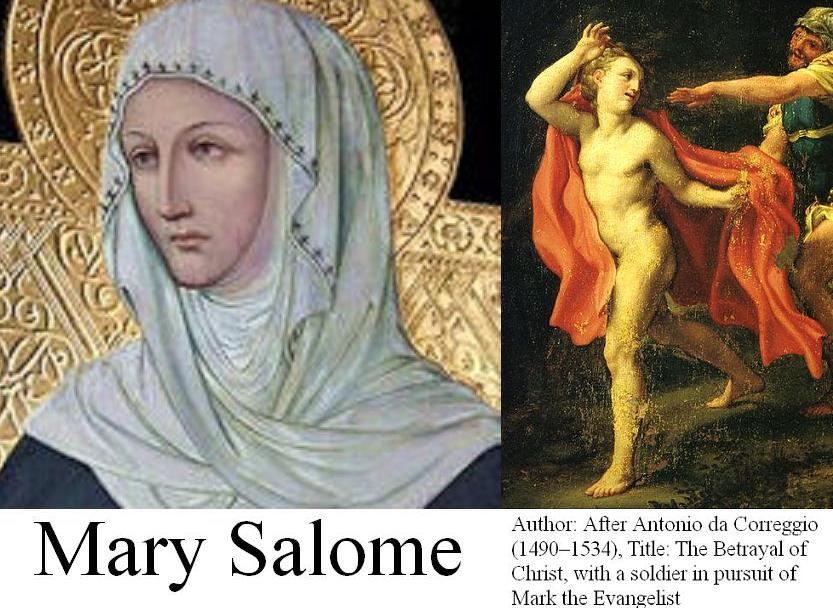
People called the boy, who begged from door to door with his mother, "nameless brat." When this boy became seven years old, DaoXin saw him on the street of HuangMei-xian and asked the boy, "What is your name?" The boy answered, "My name is Buddha nature." DaoXin fell in love with this boy and asked his mother to let the boy become his disciple, without the faintest idea that the boy was a reincarnation of the hermit of Mount Potou. The mother consented to his request to take her son as his disciple. Then the boy became a monk at HuangMeiShan Dongshan temple. This nameless brat is said to have later become the Fifth Patriarch Hongren.
This story is not only reminiscent of virgin birth of Jesus but also implies the possibility that HongRen was DaoXin's own son, just as Mark, the author of the Gospel of Mark, is suspected Jesus' own son, because his mother, Salome Mary, the owner of the house where the Last Supper was held, shared the bed and the dining table with Jesus according to the Gospel of Thomas.
What is "Baptism with The Holy Spirit"?
According to the dialectic of the Gospel of John,
【Thesis】
"A man can possess eternal life through accepting testimony of the Son of man and being baptized by him." (John 5:24)
【Anti-thesis】
But "The one who comes from the earth cannot accept the testimony by one from heaven." (John 3:32)
How then can a man possess eternal life?
【Synthesis】
"If you want to be baptized with the Holy Spirit, you can just go back to the word which was with God in the beginning (John 1:1) and certify that God is truthful. (John 3:33)"
When he said, "You are Huichao," Zen Master Fayan thrusted vivid Self in Huichao in front of his eyes.
Purchase here
○One world:
Your Comments / Unsubscribe
SEAnews Messenger
SEAnewsFacebook
SEAnews eBookstore
SEAnews world circulation
